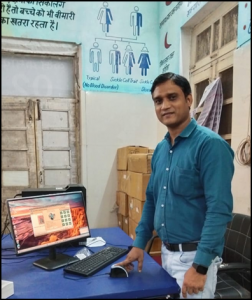Onboarding & Implementation of Biometric Attendance System in Durg District

The Government of India has been emphasizing the importance of transparency, accountability, and efficiency in public service delivery. One of the significant reforms in this direction is the adoption of the Aadhaar Enabled Biometric Attendance System (AEBAS) across government offices. In Durg district, the District Administration has taken proactive steps to ensure successful onboarding and implementation of this system in all health department offices, making it a model for punctuality and discipline.
About AEBAS
The Aadhaar Enabled Biometric Attendance System (AEBAS) is a real-time, web-based system designed to monitor the attendance of government employees. It uses biometric authentication, primarily through fingerprint or iris scan, linked to Aadhaar to ensure accuracy and prevent duplication or proxy attendance. The system is hosted on a centralized platform and allows higher authorities to track attendance records, analyze punctuality, and ensure better workforce management.
Implementation in Durg District
Recognizing the importance of punctuality in government functioning, the Durg District Administration initiated a structured program to onboard all offices and institutions onto the Biometric Attendance System. To make the process smooth, special training sessions were organized for nodal officers and department staff. These sessions provided guidance on registration procedures, troubleshooting, and the effective use of the Aadhaar-based system.
As a result of these efforts, 2368 officers and employees across the district have been successfully registered on the platform. Out of these, nearly 70% of employees are already marking their attendance daily using the biometric system, reflecting its wide acceptance and utility.
In the healthcare sector, which forms the backbone of essential public services, the system has been effectively rolled out. So far, 2 Government hospitals, 9 Community Health Centers (CHCs), 30 Primary Health Centers (PHCs), and 109 Sub-Health Centers (SHCs) have been brought under AEBAS. This ensures that doctors, nurses, and support staff adhere to duty schedules, thereby strengthening public trust in health institutions.
Benefits of Biometric Attendance
The adoption of AEBAS in Durg district has yielded multiple benefits:
1- Ensuring Punctuality: The system minimizes late arrivals and early departures, instilling a culture of discipline among employees.
2- Transparency and Accountability: As the system records attendance in real time, it eliminates the scope for manipulation, proxy marking, or errors.
3- Better Monitoring: Supervising authorities can monitor attendance trends across offices, identify gaps, and take corrective measures promptly.
4- Improved Public Service Delivery: Regular attendance of staff directly translates into timely services for citizens, particularly in critical sectors like health and education.
5- Digital Governance: AEBAS aligns with the broader goal of Digital India by bringing e-governance practices into the daily functioning of government offices.
Way Forward
The initial phase of implementation in Durg has been highly encouraging. With the majority of employees adapting to the biometric system, the district is witnessing enhanced efficiency and discipline. However, the administration is also committed to addressing challenges such as technical glitches and connectivity constraints in remote areas. Regular feedback from offices and continuous training will further strengthen the system’s effectiveness.
Conclusion
The onboarding and implementation of the Biometric Attendance System in Durg district marks a significant step toward transforming governance practices. By ensuring punctuality, accountability, and improved service delivery, the system reflects the district’s commitment to citizen-centric governance. As more offices and institutions adopt AEBAS, Durg is setting an example for other districts to follow, showcasing how technology can be leveraged to bring discipline and efficiency into public administration.




 Subscribe
Subscribe
 Flipbook
Flipbook PDF (5.0 MB)
PDF (5.0 MB)


